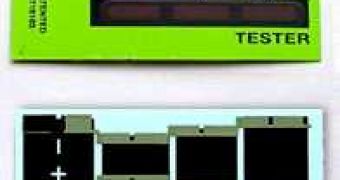Personally, I've never seen such a device in action; to be more precise, I've never seen one at all! The only time I observed a battery tester was some years ago on a counterfeit battery that had one imprinted on it. I mean its image, not the actual device. Battery testers have been eluding me for some time, mostly because I have no interest in them or how they work, but they are probably among the best examples of combined technologies currently existing.
Battery testers use two types of special inks: thermochromic and conductive. Thermochromic inks have the capability of changing color according to the temperature that they are subjected to. Conductive inks, on the other hand, allow the flux of electric current.
There are two types of thermochromic inks: liquid crystal and leucodye. Liquid crystal ink is very sensitive to small variations in temperature, while leucodyes have the ability to change color when subjected to variations in temperature of about 3 degrees Celsius or more. Most battery testers have sensitivities between 37.7 and 48.8 degrees Celsius.
The conductive ink is used a substrate, narrowing from the 'good' to 'bad' markings of the battery tester meter. As the current is circulated through the conductive ink, it tends to heat up, thus transferring thermal energy to the thermochromic ink, which changes its color accordingly.
The two ink layers are protected by an additional one, made of normal transparent ink. Usually when the thermochromic layer of the battery tester is cold, it has a black color. However, when pressure is applied, the circuit created by the conductive ink is closed, thus making a connection between the positive and negative terminal of the battery. The current circulating through the conductive ink layer will start to generate heat, thus turning the thermochromic ink clear.
If there is enough electric current in the battery, then the tester will generate enough heat to turn all thermochromic ink clear, indicating that it is full. Albeit, if there is not enough heat generated, the thermochromic ink will only become partially translucent.
Usually, battery testers do not interfere with the correct operation of batteries; however, its excessive use may eventually drain the battery.

 14 DAY TRIAL //
14 DAY TRIAL //